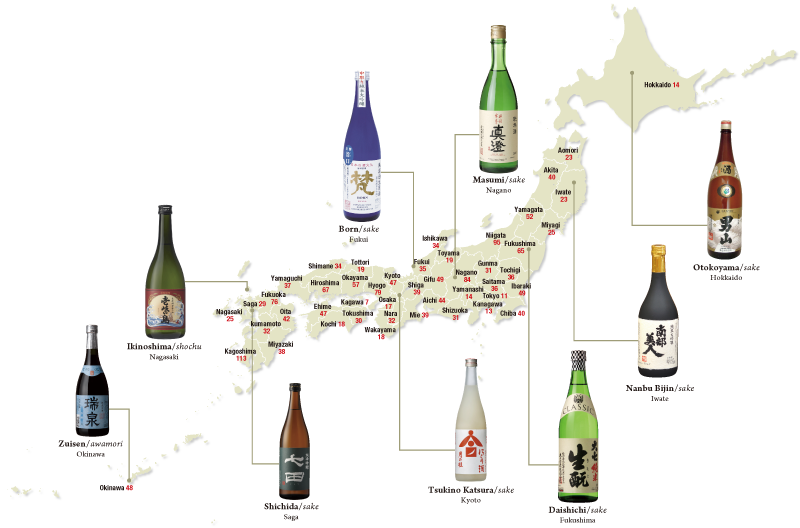Home > Highlighting JAPAN > Highlighting Japan SEPTEMBER 2012 > Special Brews
Highlighting JAPAN
COVER STORY: Kampai!—A GUIDE TO JAPANESE ALCOHOLIC BEVERAGES
Special Brews
Japanese alcoholic drinks such as sake and shochu are produced all over Japan, but they come in a range of different varieties and tastes, depending on factors such as their ingredients or the region’s climate. Mainly in the areas producing a large amount of rice, sake is produced in Hokkaido, Honshu and Shikoku, while shochu and awamori are favored on the southern islands of Kyushu and Okinawa respectively. Exports have been on the increase in recent years, as more and more people in other countries start to enjoy Japanese alcoholic drinks. From among the more than 1,800 sake breweries and shochu distilleries in Japan, we profile a few leading representatives whose products are currently available overseas.
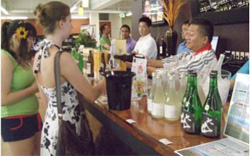
Otokoyama tasting party in Seattle, July 2011
Established in 1887 in the city of Asahikawa in Hokkaido, Otokoyama Co. is the brewer of Otokoyama, one of Hokkaido’s representative sakes. Working with temperatures that can get as low as minus 20 in central Hokkaido, Otokoyama brews sake from frozen underground water from the Taisetsu Mountains, which you can see from the brewery itself. Its fine and dry taste is evaluated as one of the best Japanese dry sakes overseas. Otokoyama has been winning international liquor contests such as the World Selection of Spirits and Liqueurs for thirty-six consecutive years, since 1977.
At present, 13% of the sake brewed at Otokoyama is exported. Its largest export market is the United States, which accounts for around 70% of that total. The rest is exported to other Asian countries. Otokoyama’s products are sold in Japanese supermarkets around the world, as well as being served in Japanese restaurants.
The brewery also runs the Otokoyama Sake Museum, which features brewing-related exhibits and tools, and even offers visitors free samples of Otokoyama sake. It attracts around 120,000 visitors each year, 50,000 of whom are tourists visiting from overseas, particularly Asian countries. On the second Sunday of February each year, the brewery organizes an event that gives visitors the chance to sample the year’s new sake for free, go on a tour of the brewery and buy a range of sakes and confectionery. Despite the freezing temperatures, the event attracts many people every year, including visitors from overseas as well as local residents.
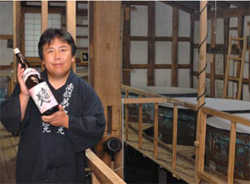
Kosuke Kuji, fifth-generation owner of the Nanbu Bijin Co. brewery, holding a bottle of the sake of the same name
Credit: AKIHIRO MURAKAMI
Located in the inland part of northern Iwate Prefecture, the city of Ninohe is surrounded by glorious natural scenery, nestled between the Kitakami and Ou Mountains. Nanbu Bijin Co., the brewery of Nanbu Bijin sake, was established in the center of Ninohe in 1902.
As the key ingredient in sake, the brewery is particular about the rice it uses above all else. In fact, it mainly uses rice that has been developed in Iwate Prefecture, specifically for use in sake. It draws its water meanwhile from a well that bubbles up on the site of the brewery itself. Rich in minerals such as potassium, phosphorous and magnesium, the well water is a slightly bluish color. The minerals help the yeast and koji rice malt to propagate and ferment, producing a finished product with a rich, robust taste.
Nanbu Bijin sakes are exported to twenty-one countries around the world, including the United States, United Kingdom, Brazil and Singapore, where they are mainly served in Japanese restaurants. It has built up quite a following outside Japan. People are often surprised at how a drink made from rice can be so fresh and fruity, unlike any sakes they have tried before. In 2010, the brewery’s daiginjo sake Nanbu Bijin won gold in the daiginjo category at the U.S. National Sake Appraisal in Honolulu, Hawaii.
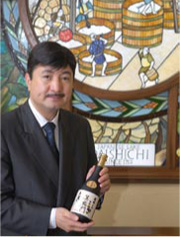
Hideharu Ohta, president of Daishichi Sake Brewery Co., holding a bottle of Minowamon
Credit: AKIHIRO MURAKAMI
Established in 1752 in the city of Nihonmatsu in Fukushima Prefecture, surrounded by lush greenery at the foot of Mount Adatara, Daishichi Sake Brewery Co. is renowned for brewing sake using the “kimoto method” and the “super-flat rice polishing technique.” Developed as a brewing technique some 300 years ago, the kimoto method involves slowly growing natural Lactobacillus bacteria to produce sake. The super-flat rice polishing technique meanwhile was used by the brewery on a commercial scale for the first time in 1995. The technique removes as many proteins, fats and other substances as possible from the surface of the rice, to prevent them from affecting the flavor of the resulting sake. Although these techniques require more time and effort than regular brewing methods, they produce sake with a truly mellow taste. Daishichi always features prominently in lists ranking Japan’s favorite sakes.
In December 2010, the brewery’s daiginjo sake Minowamon had the honor of being served at a banquet hosted by the Dutch royal family. Renowned sommelier Shinya Tasaki praised Minowamon, commenting, “It has a soft, smooth flavor that creates a sense of elegance from the first taste, giving way to a slightly bitter yet soothing aftertaste.” In June 2011, Daishichi became the first sake brewery to have its own booth at Vinexpo 2011 in Bordeaux, France, the largest international alcoholic beverage exhibition in the world. The brewery’s sakes, which mature over time and develop an even more refined taste, are also proving popular with overseas chefs and sommeliers.
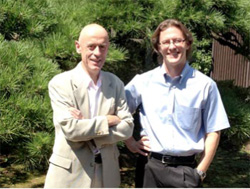
Frenchman Dominique Grandemenge (left) and American Keith Norum, who are in charge of overseas sales for Miyasaka Brewing Company
Surrounded by mountains, just a short distance from Lake Suwa, Miyasaka Brewery Co. is a long-established brewery in the city of Suwa in Nagano Prefecture, where it was founded as far back as 1662. The brewery makes its Masumi range of sakes by carefully polishing rice, most of which is grown locally in Nagano. Its brewing ethos is based on producing great tasting sake, while helping to make a happy family. With their refined sweetness, Masumi sakes are ideal for women who are lighter drinkers. They also go with other cuisines as well as Japanese, including western dishes, Chinese food and cheese. Visitors to the brewery’s own Cella Masumi store can sample Masumi sake for themselves.
Miyasaka currently exports Masumi sakes to the United States, Hong Kong, Macau, Canada and various other countries and regions. As well as being served in Japanese restaurants the world over, other restaurants are starting to offer Masumi sakes too, including local restaurants in France and Chinese restaurants in Hong Kong.
Overseas sales are handled by American and French members of staff. As well as traveling around the world marketing the brewery’s products, they also give managers, members of staff and sommeliers at restaurants serving Masumi advice on how best to drink and store their sakes. Numerous restaurant owners and members of staff have come over to Japan to visit the brewery too.
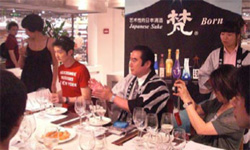
Atsuhide Kato, eleventh-generation owner of Katou Kichibee Shouten brewery, at a tasting party in Shanghai, China
Starting sake production in 1860, Katou Kichibee Shouten collects data via management sensors to measure and control temperature and moisture levels in production sectors which had previously mainly relied on expert instinct and experience. The system is designed to achieve reproducibility of high quality sakes at an extremely consistent level. The brewery’s Born range consists of junmai ginjo sakes made entirely from rice, koji and water. Sakes are aged at temperatures below zero for about one to ten years, producing a very smooth and rich taste.
The brewery began selling sake overseas during the early part of the 1990s. Born has received many top prizes at various international contests overseas. The brewery currently exports its products to around forty different countries and regions, including the United States and Asia. The trademark of Born is officially registered in over 100 countries. Born sakes are available to buy and drink at top restaurants in major cities such as Paris and New York and in specialist sake stores in the United States.
Born has been offered at numerous international events at home and abroad too, including the opening banquet for the 2002 FIFA World Cup in Japan and South Korea. And in 2009, Japan’s then prime minister presented Born to President Barack Obama to celebrate his inauguration.

The toji master brewer mixes koji mold into steamed rice.
Fushimi in Kyoto Prefecture has been a renowned sake brewing area since before the Edo period (1603–1867). The Fushimi brewery with the longest history is Masuda Tokubee Shoten Co., dating all the way back to 1675. It is best known for brewing Tsukino Katsura, the first ever nigorizake in Japan. Nigorizake is white, cloudy sake that has a fizz, fruity aroma and crisp acidity similar to that of sparkling wine.
The brewery’s sakes are currently exported to around twenty different countries and regions, and are sold by the likes of specialist sake stores in the United States, Germany and Switzerland and high-end hotel and bars in France. They are also served in top restaurants in New York.
In January 2012, the brewery launched Kasegi Gashira, its first ever product aimed at the overseas market. Kasegi Gashira is a light, fruity sake, completely unlike the convential image of sake with a reduced alcohol content of 8%.
Located just half an hour by train from the center of Kyoto, the brewery attracts a great many tourists from all over the world, eager to come and look round the brewery and sample its products.
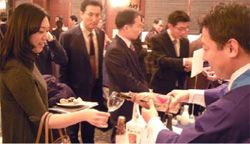
Tenzan Sake is offered at a tasting party in Seoul, South Korea, in January 2010
Established in the city of Ogi in 1875, Tenzan Sake Brewer Company is one of the main sake breweries in Saga Prefecture. Ogi itself is renewed for its spring water. The crystal clear waters of the Gion River, which flow down from the Tenzan Mountains and through the city, are famous for attracting hundreds of thousands of fireflies from May to June each year. The brewery’s sakes are made from spring water drawn from the Tenzan Mountains. Rich in minerals such as calcium and magnesium, the area’s hard water produces a dry sake with a clean taste.
The brewery’s sakes are exported to more than ten different countries and regions, where they are mainly served in Japanese restaurants. Jizake Tenzan, which at 18% has a slightly higher alcohol content than regular sakes, is recognized as a “masculine” sake in the United States. In July this year, Jizake Tenzan one of the brewery’s four gold award winners at the U.S. National Sake Appraisal in Honolulu, Hawaii.
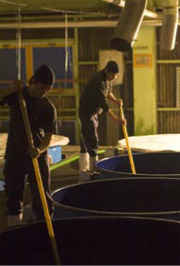
At Ikinokura Distillery, a worker stirs moromi into a tank using a large paddle, in the traditional process known as kaiire.
One of the reasons why so much shochu is produced in Kyushu is its warmer climate, which is ideal for the koji mold used to make shochu. Made principally from barley, shochu was first produced in Japan at the start of the sixteenth century on Ikinoshima Island, roughly 20 km off the northern coast of Kyushu. Ikinokura Distillery Co. is one of the main distilleries on Ikinoshima. In 1984, six of the island’s long-established distilleries came together to form a group. Using rice for koji is a characteristic of barley shochu in Ikinoshima. Ikinoshima, which is representative of Ikinokura’s shochu, is superbly blended, having the taste of rice koji and the aroma of barley. Using yeast isolated from dianthus flowers, the barley shochu Nadeshiko has a rich fragrance and elegant taste. In 2011, Ikinoshima received the Grand Gold Quality Award and Nadeshiko the Gold Quality Award from Monde Selection, the international quality-rating organization based in Brussels, Belgium.
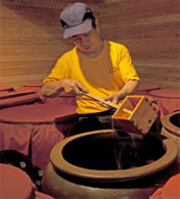
The shitsugi process of aging awamori to make kusu entails the periodic transfer of a set amount of awamori through a sequence of pots, from the oldest to the newest.
The main alcoholic beverage produced in Okinawa is awamori, a distilled drink similar to shochu. Although Okinawa is now home to forty-seven distilleries, Zuisen Distillery Co. is one of the prefecture’s longest established producers of Ryukyu awamori, dating back to 1887. Located in the city of Naha, next to World Heritage site Shurijo Castle, the distillery attracts crowds of tourists on a daily basis.
It is particularly focused on producing the aged variety of awamori called kusu. Ryukyu kusu was always a highly prized type of awamori, so much so that it was reportedly served in the court of the Ryukyu Kingdom, to welcome visitors from afar. The kusu awamori produced by Zuisen is aged in unglazed clay pots for anything from three to twenty years, creating a mellow, rounded taste with a pleasantly sweet aroma.
Coming in at 30% to 43% alcohol, awamori is slightly stronger than regular shochu. As well as being mixed with cold water, hot water or ice, awamori is also recommended in cocktails, used as a base with other ingredients such as cola, liqueurs or fruit juice.
Zuisen began shipping its products to other countries in 2002 and currently exports to around ten different countries and regions, including the United States. Its sakes are also served in Okinawan restaurants in Hong Kong, China and Singapore.
Sake and Shochu Brewers by Prefecture
The figures show the number of brewers who are registered with their respective prefectural brewers’ associations. There are 1,853 brewers registered in all.
© 2009 Cabinet Office, Government of Japan
